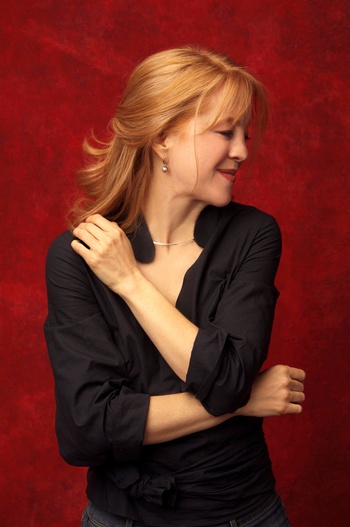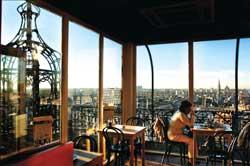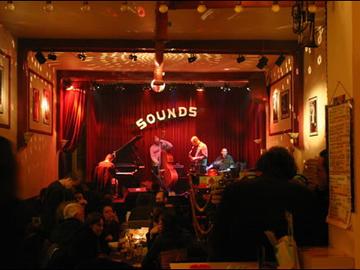The Brussels Jazz Orchestra has not only recruited a star to celebrate its 25th birthday, but she is also a passionate bird watcher who constantly scans the horizon: Maria Schneider.
This is not the first time that the American composer, who for years has also conducted her own Maria Schneider Orchestra, will perform with Frank Vaganée’s big band, but she did not have quite so many victories to her name at that point. Nowadays, records by the artist, who was mentored by Gil Evans, are universally praised to the skies by the specialist press and she has been winning one Grammy after another. The last two were for her arrangement of “Sue (Or in a Season of Crime)”, which she recorded with the late David Bowie, and for her latest studio album, The Thompson Fields (2015). The short upcoming joint European tour with the Brussels Jazz Orchestra (BJO) will primarily feature compositions from that album.
On The Thompson Fields, you reflect on your youth in the American Midwest. Was that your initial intention?
Maria Schneider: No, when I record an album, the theme only reveals itself either somewhere along the journey or at the end. In this case, all the compositions seemed in one way or another to be connected to my rural childhood and my love of nature.
I am a passionate bird watcher. When people ask me about my favourite song, I always answer that it is the song of the hermit thrush. With the BJO we will also perform a piece from Sky Blue (2007) that is about bird migration. When I came home after a morning of bird watching in Central Park and tried to write music, that composition suddenly came into my head. It illustrates how music always mirrors life, or at least in my case. What you eat is what you become or what you are. Some musicians consciously choose what or who they want to be influenced by, and that sometimes also happens to me. But I am actually much more inspired by extra-musical things that flow directly from my personality or my life.
You currently live in New York. Do the birds sing differently there than in Minnesota?
Schneider: It is very different. Minnesota has a lot of open grassland where you can hear prairie birds. New York is primarily home to migratory birds that come from Central and South America. Because more and more native prairie is being destroyed in the Midwest in favour of cornfields and agricultural land, and people are also planting more trees, many bird populations are actually migrating from the east to the west. We are changing our natural environment and that has a direct impact on the bird population.

Not long ago, the BJO performed a programme in honour of the late Gil Evans, the master arranger who worked with Miles Davis and was your mentor. Do you look up to him and what did you learn from being around him?
Schneider: I thought of him a little like Yoda from Star Wars. [Laughs] Even though he looked like a royal wizard, whenever we worked together he was incredibly kind and not arrogant at all. When I arrived he would just ask me if I wanted some apple juice.
His humility obviously stood in sharp contrast to his musical baggage. At school they teach you how to play an instrument but not how to be a real artist. Gil had the gift of making things that go way beyond being music.
Wayne Shorter once told me that Miles Davis had told him that he liked music that didn’t sound like music. Gil also advocated that kind of total experience and made me see that I first had to find my own voice to be able to transform that individualism into something greater.
I am a passionate bird watcher. When people ask me about my favourite song, I always answer that it is the song of the hermit thrush
“Sue (Or in a Season of Crime)”, the one composition that you made with David Bowie, was also to be his last because he passed away. What do you remember most about collaborating with him?
Schneider: The fact that he was open enough to try the craziest things. He encouraged me to be very experimental. We were also very lucky in that we agreed on almost everything. I was particularly impressed by the orchestral version of the song. The drums were amazing and the song had a wild rock harmony. For me, it was the ideal collaboration because I would never have thought of it myself and he would never have been able to put our version on his album without me. In this case, one plus one was definitely more than two.
During rehearsals you often put the big band in a circle. Why do you do that?
Schneider: Then at least everyone can see what they are hearing. You really can’t underestimate that visual contact at the beginning of a rehearsal period. In terms of atmosphere it also makes a change for the musicians, who are usually arranged behind one another. It’s a good thing you reminded me because I don’t think I have ever done that with the BJO. [Laughs]
Do you still work with enormous manuscript sheets?
Schneider: Oh yes, I can’t stand computers. To me that is the only way of testing ideas. I really don’t understand how people who write on computers can develop ideas because the computer notes everything down for you. I hear music as music, I don’t see notation. Composing on a computer is like designing a house with Lego blocks. I always want to keep the option open that it could turn into something totally different.
> Brussels Jazz Orchestra 25 years with Maria Schneider. 10/10, 20.15, Flagey




Fijn dat je wil reageren. Wie reageert, gaat akkoord met onze huisregels. Hoe reageren via Disqus? Een woordje uitleg.